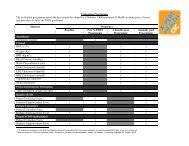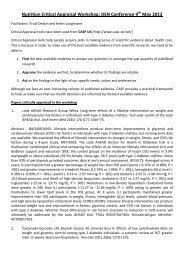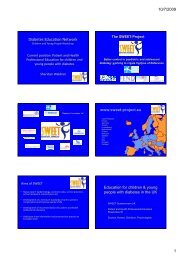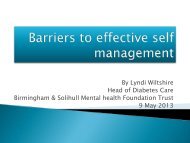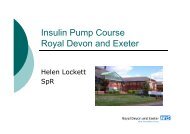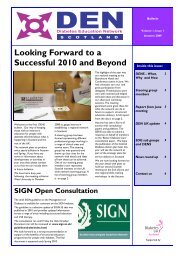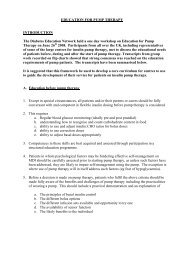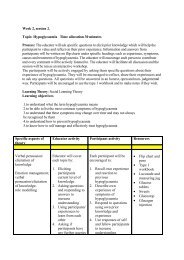Insulin Pump Workbook - The Diabetes Education Network
Insulin Pump Workbook - The Diabetes Education Network
Insulin Pump Workbook - The Diabetes Education Network
Create successful ePaper yourself
Turn your PDF publications into a flip-book with our unique Google optimized e-Paper software.
<strong>Insulin</strong> <strong>Pump</strong> <strong>Workbook</strong><br />
Local Phone Numbers:<br />
<strong>Pump</strong> manufacturers helpline:<br />
Developed by Joan Everett and Dr Helen Lockett on behalf<br />
of <strong>Diabetes</strong> <strong>Education</strong> <strong>Network</strong><br />
1
Page 3<br />
Page 4<br />
Page 5<br />
Page 6<br />
Page 7<br />
Page 8<br />
Page 10<br />
Page 11<br />
Page 12<br />
Page 13<br />
Page 14<br />
Page 15<br />
Page16<br />
Page 17<br />
Page 18<br />
Page 23<br />
Page 30<br />
Page 31<br />
Page 33<br />
Page 36<br />
Page 37<br />
Page 38<br />
Page 39<br />
Page 41<br />
Page 42<br />
Page 43<br />
Page 45<br />
Page 46<br />
Contents<br />
About this workbook<br />
Introduction<br />
Your expectations of pump therapy<br />
Advantages and disadvantages<br />
Summary of reasons for your pump start<br />
<strong>Insulin</strong> pump therapy agreement<br />
Why is insulin necessary<br />
Blood Glucose Monitoring<br />
How to work out your basal rate<br />
How to work out your insulin to carbohydrate<br />
ratio<br />
How to work out your correction dose<br />
Getting started<br />
Basic functions of your pump: Insertion sites<br />
Insertion site management<br />
Low blood glucose levels<br />
High blood glucose levels<br />
Case scenarios<br />
Checking your insulin to CHO ratio<br />
Checking your basal rate<br />
Fasting basal rate sheet<br />
Using temporary basal rates<br />
Activity and exercise<br />
Advanced bolus options<br />
<strong>Pump</strong> failure<br />
Alcohol<br />
Travel<br />
Hospital admission<br />
Emergency kit<br />
2
About This <strong>Workbook</strong><br />
Welcome to this workbook. It aims to offer background information to<br />
support you starting on insulin pump therapy and it is designed to be<br />
used by both health professional and patients.<br />
Some of the topics in the workbook are addressed using a question<br />
and answer technique and these sections try to cover the most<br />
frequently asked questions. You will also see symbols at various<br />
points and these are designed to encourage you to think about the<br />
way you manage your diabetes. If you are part of a group, you may<br />
want to discuss the issues<br />
What do the symbols mean<br />
This symbol indicates something<br />
for you to think about, or a<br />
question<br />
This symbol indicates something<br />
you may wish to discuss in your<br />
group<br />
This symbol represents<br />
frequently asked questions<br />
This is your own personal and private booklet; no one will ask to look<br />
at it, so you can keep it private or share it as you wish.<br />
3
Introduction<br />
<strong>The</strong> aim of this workbook is to provide you with the information<br />
necessary to enable you to manage your diabetes using insulin pump<br />
therapy.<br />
Thinking about the following questions may help you get the most<br />
from starting pump therapy.<br />
What are your reasons for starting insulin pump therapy<br />
What frustrates you now about your diabetes<br />
4
What are your expectations about pump therapy<br />
What do you hope to achieve by converting to an insulin pump<br />
What are your fears or worries you have about starting pump<br />
therapy<br />
My personal goal for pump therapy is:<br />
If you are part of a group please remember that everything<br />
discussed should be considered confidential to the group.<br />
5
What are the advantages of insulin pump therapy<br />
What are the disadvantages of insulin pump therapy<br />
6
Possible Reasons to Convert to an <strong>Insulin</strong> <strong>Pump</strong><br />
Please tick the boxes that you feel are relevant to you:<br />
Repeated episodes of hypoglycaemia despite high self-care<br />
Reduced awareness of hypoglycaemia<br />
Rise in blood glucose in the early hours of the morning, called the<br />
“dawn phenomenon”<br />
Wide fluctuations in blood glucose level despite intensive multiple<br />
injection insulin regime<br />
Pre-conception or pregnancy<br />
Requiring very small amounts of insulin or <strong>Insulin</strong> sensitivity<br />
HbAIc over 8.5%<br />
□<br />
□<br />
□<br />
□<br />
□<br />
□<br />
□<br />
I feel that I am …..(tick all boxes relevant to you)<br />
Motivated to succeed<br />
Able to self-manage and problem solve<br />
Willing to test blood sugars at least 4 times a day<br />
Competent at carbohydrate counting<br />
Competent at insulin adjustment for carbohydrate, blood sugar<br />
and lifestyle<br />
Willing to work with the multi-disciplinary team<br />
Aware of the insulin pump agreement<br />
□<br />
□<br />
□<br />
□<br />
□<br />
□<br />
□<br />
7
<strong>Insulin</strong> <strong>Pump</strong> <strong>The</strong>rapy Agreement<br />
Benefits of <strong>Insulin</strong> <strong>Pump</strong> <strong>The</strong>rapy - General<br />
Although insulin pump therapy can be successful, this form of<br />
treatment is time-consuming and expensive. <strong>The</strong>refore, it is important<br />
that people on pumps continue to benefit in the long-term. <strong>The</strong><br />
potential benefits are:<br />
Less frequent severe hypoglycaemia<br />
Return of early warning symptoms of hypoglycaemia<br />
Improved glucose control<br />
Better quality of life<br />
<strong>The</strong> reduction in HbA1c level should be at least 0.5% less than your<br />
average level before starting on the pump (unless your HbA1c is less<br />
than 7.5%)<br />
Also, in order to benefit from the pump, it is important that you are<br />
confident in:<br />
Using the technical features of the device<br />
Altering the amount of insulin depending on the carbohydrate<br />
content of meals, exercise etc<br />
Measuring blood glucose levels to use correction doses<br />
We anticipate that you will see the benefits after 3-6 months of starting the<br />
pump. <strong>The</strong>se need to be maintained in the longer term. It will be<br />
necessary to measure the benefits by checking your HbA1c level,<br />
awareness of hypoglycaemia and quality of life (using questionnaires) at<br />
regular intervals.<br />
8
Benefits of <strong>Insulin</strong> <strong>Pump</strong> <strong>The</strong>rapy – Patient Specific<br />
We recognise that there may be other reasons why pump therapy may<br />
benefit you.<br />
1. …<br />
2. …<br />
3. …<br />
If, however, the pump does not prove to be successful based on the<br />
above, it may be necessary to look at alternatives.<br />
Terms of agreement<br />
I, the undersigned, recognise that it is important that there should be<br />
demonstrable benefits to me with continuing use of insulin pump<br />
therapy. I agree to the above being measured on a regular basis and<br />
used to evaluate the benefits of insulin pump therapy.<br />
I understand that continued funding for the pump (including<br />
consumables) is dependant on my active participation in on-going<br />
education and by demonstrating measurable improvements in my<br />
diabetes control.<br />
Signed<br />
Please print name<br />
Date<br />
9
Why is <strong>Insulin</strong> Necessary<br />
<strong>The</strong> diagram below represents what happens in someone without<br />
diabetes. Background insulin is necessary to maintain blood glucose<br />
levels whether people are eating or not. <strong>The</strong> pancreas produces a<br />
small amount of insulin continually to maintain normal blood glucose<br />
levels. <strong>The</strong> pancreas automatically increases or decreases insulin<br />
production according to the blood glucose level.<br />
When food containing carbohydrate is eaten, the pancreas produces<br />
exactly the right amount of insulin to keep blood glucose levels within<br />
the normal range. <strong>The</strong> insulin that is secreted after breakfast, lunch<br />
and the evening meal is shown by the three peaks in the diagram<br />
below.<br />
Food insulin<br />
Background<br />
insulin<br />
Breakfast<br />
Mid-day meal<br />
Evening meal<br />
<strong>Insulin</strong><br />
Daily insulin requirements vary from person to person. <strong>The</strong> aim of<br />
insulin pump treatment is to mimic the pancreas by using short acting<br />
insulin to give a background (basal) rate which is pre-programmed in<br />
and delivered in small pulses. In addition you can press buttons to<br />
deliver a bolus to cover carbohydrate eaten or give a correction dose.<br />
10
Blood Glucose Monitoring<br />
Measuring blood glucose is a way of monitoring your diabetes. By<br />
using the blood test results you can learn how different things can<br />
affect your diabetes, such as the food you eat, the exercise you take,<br />
or illness and stress.<br />
Blood glucose monitoring will give you information about YOUR<br />
response to all of the above. It should help you see what’s working<br />
and what’s not. Each blood glucose reading is a learning experience.<br />
What are the benefits to you of blood glucose monitoring at the<br />
moment<br />
What may stop you doing blood tests<br />
What is your target blood glucose level<br />
How many blood tests will you expect to do on the pump<br />
11
Calculating Your Basal Rate<br />
You may need approximately 25 - 30% less insulin on a pump than<br />
your present requirements because of the way the insulin is delivered<br />
Working it out:<br />
1. On average, how much short acting insulin are you injecting in<br />
24hours e.g. 24 units<br />
2. How much long acting insulin do you inject in 24 hours e.g. 20<br />
units<br />
3. Add both together to give your pre-pump total daily dose e.g. 44<br />
units<br />
4. Take 30% off pre-pump total daily dose. This is now your total<br />
daily pump dose e.g. 70% of 44 units = 30 units<br />
5. Divide your total daily pump dose by 2 to give your total basal<br />
rate in 24 hours e.g. 30 ÷ 2 = 15 units<br />
6. Divide by 24 to give an hourly basal rate e.g. 15 / 24 = 0.6 units<br />
per hour<br />
Now calculate your basal rate<br />
Short acting insulin =<br />
Long acting insulin =<br />
Total =<br />
-30% =<br />
Divide by 2 =<br />
Divide by 24 = My starting basal rate is…………..<br />
It is usual to start with a flat basal rate but you and<br />
your team may decide differently. <strong>The</strong> pump has the ability to deliver<br />
different basal rates during the 24 hour period. <strong>The</strong>se will be<br />
determined according to your individual needs over the next few<br />
weeks. Most people have between 1 – 6 different basal rates<br />
12
Calculating Your <strong>Insulin</strong> to Carbohydrate (CHO)<br />
Ratio<br />
You may be using an insulin to carbohydrate ratio that is based on<br />
the number of units of insulin for each 10g of carbohydrate or CP<br />
(carbohydrate portion). When using a pump it is more common to<br />
have a ratio where 1 unit of insulin is given for a calculated amount of<br />
carbohydrate. This allows more accurate bolus dose calculation. Use<br />
the equation below to calculate your pump insulin to carbohydrate<br />
ratio. Alternatively your diabetes team may decide to continue your<br />
present insulin to carbohydrate when you commence pump therapy.<br />
If this is the case please move on to the next section.<br />
Working it out:<br />
1. Calculate your total daily pump dose as above e.g. 30 units<br />
2. Divide this into 500 e.g. 500 ÷ 30 = 16.6 rounded to 15: This<br />
means you will need approx 1 units of insulin for every 15g<br />
CHO<br />
Now calculate your insulin to carbohydrate ratio<br />
Total daily pump dose =<br />
500 ÷ total daily pump dose =<br />
I need to take 1unit of insulin for ……..…g of carbohydrate<br />
Compare this with your previous ratio and decide with your team what<br />
you will use<br />
13
Calculating Your Correction Dose<br />
This is how much 1 unit of insulin will reduce your blood glucose level<br />
by.<br />
Working it out:<br />
1. Calculate your total daily pump dose as above e.g. 30 units<br />
2. Divide this into 100 e.g. 100 ÷ 30 = 3.3. This means that 1 unit<br />
of insulin will reduce your blood glucose level by approx<br />
3mmol/l<br />
Now calculate your correction dose<br />
Total daily pump dose =<br />
100 ÷ total daily pump dose =<br />
1 units of insulin will reduce my blood glucose by ….…..mmol/l<br />
How much insulin would you give, as a correction bolus, if<br />
your blood glucose is 10 mmol/l pre meal and your target<br />
blood glucose level is 6mmol/l<br />
14
What <strong>Insulin</strong> Will be Used in My <strong>Pump</strong><br />
Only short acting insulin is used in insulin pumps.<br />
<strong>The</strong> analogue insulins commonly used are<br />
• Lispro (Humalog)<br />
• Aspart (Novorapid)<br />
• Gluilisine (Apidra)<br />
You will be able to obtain your insulin in the usual way from your GP<br />
by prescription however you will require 10ml vials rather than the<br />
insulin cartridges used in pens.<br />
Getting Started<br />
What do you need<br />
• Your pump<br />
• Short acting insulin in 10ml vial<br />
• Reservoir<br />
• Your chosen cannula and insertion set<br />
• Blood glucose monitor<br />
• Completed audit questionnaires<br />
• Any final questions or concerns<br />
15
<strong>The</strong> Basics of <strong>Insulin</strong> <strong>Pump</strong>s<br />
You will be taken through the basic functions of your pump by the<br />
diabetes team and the pump manufacturer’s instruction book.<br />
You will cover<br />
• Inserting batteries<br />
• Setting time and date<br />
• Switching pump on/off<br />
• How to give a bolus<br />
• How to set basal rates<br />
• How to fill up a cartridge<br />
• How to insert a cartridge<br />
• Different insertion devices<br />
Insertion Sites<br />
Below is a diagram that show the best sites to insert your cannula.<br />
16
Infusion Site Management<br />
• It is best to avoid any ‘lumpy’ or heavily used sites<br />
• Ensure you rotate your infusion sites<br />
• <strong>The</strong> infusion set should not be sited directly on the belt line or<br />
under the waistband<br />
• Think of things like seat belts<br />
• Insert the new infusion set at least 5cm away from the old site<br />
• Some people prefer to stand while inserting<br />
• Change infusion sets every 2 – 3 days<br />
• Always check blood glucose level two hours after inserting<br />
cannula to ensure it is working<br />
• Best time to change site is after a bath but not late at night as<br />
you need to ensure that the cannula is working before you go to<br />
sleep. Failure to absorb insulin overnight may result in ketones<br />
• Another good time to change is before a meal so that the meal<br />
bolus ensures any clearing of tissue or blood left in cannula.<br />
• Leave old infusion set in until the new one is in place. Some<br />
people leave it in for up to 2 hours<br />
• Examine your cannula after removal to check for kinking or<br />
bending. Consult your diabetes team if this happens regularly<br />
• Infusion sites are sometimes painful after insertion. If still<br />
painful after one hour it is best to change the cannula and site.<br />
You may experience a slight stinging sensation<br />
• If you see blood in tubing, your infusion site will need to be<br />
changed<br />
• Tea tree cream is useful to help heal scars<br />
Preventing Infection<br />
• Wash your hands before you open any package<br />
• Wash your hands after touching the old site<br />
• Use no touch technique for ends of tubes<br />
• Change set at first sign of pain, redness or discomfort<br />
17
What to Do When Your Blood Glucose Is Low<br />
Hypoglycaemia means low blood glucose and is commonly called a<br />
“hypo”.<br />
Think back to your last hypo and consider<br />
the events that may have led to it.<br />
<strong>The</strong> three most common causes of hypos are:<br />
• Too much insulin<br />
• Overestimation of carbohydrate content of food<br />
• More physical activity than planned<br />
When you have a hypo how do you feel<br />
What warning symptoms do you have<br />
18
What blood glucose level would you count as a hypo<br />
At what level do you experience warning symptoms<br />
Generally a blood glucose level of less than 4 mmols/l is defined as<br />
the onset of hypoglycaemia. <strong>The</strong> motto often used is “Make 4 the<br />
Floor”. Maintaining your blood glucose no lower than 4mmols/l allows<br />
time for you to recognise any symptoms and take the necessary<br />
action.<br />
Remember a hypo during the previous 24 hours may increase the<br />
risk of further hypos. Any hypos can lead to unpredictable blood<br />
glucose readings over the next 24 hours due to the body releasing<br />
various hormones in response to the low blood glucose level.<br />
19
Self-treated hypos<br />
Treatment<br />
What do you use to treat your hypos<br />
In order to increase the low blood glucose levels as soon as possible,<br />
the ideal option is a glucose-rich food or drink. <strong>The</strong> table below shows<br />
some examples of treatment for hypos. Aim to initially take 15 to 20g<br />
of carbohydrate. You may be able to treat the hypo yourself, but if<br />
symptoms are severe, you may require help from others.<br />
Food<br />
10g CHO<br />
is found in:<br />
15g CHO<br />
is found in:<br />
Glucose/dextrose tablets 3 5<br />
Lucozade 50 ml 80 ml<br />
Cola-type fizzy drink<br />
(non-diet variety)<br />
100 ml 150 ml<br />
Jelly babies 3 5<br />
Jelly beans 7 10<br />
Fruit pastilles 4 6<br />
It is recommended that you take 15 - 20g fast-acting carbohydrate<br />
and then wait 10 -15 minutes, re-test and if necessary, treat again<br />
with a further 10 -15g carbohydrate.<br />
My preferred option for hypo treatment is……………………………..<br />
20
Help from Others<br />
Any of the above treatments can be given if you are able to swallow.<br />
In severe hypos you may be unconscious, in which case your family<br />
and friends may be taught how to give you a glucagen injection.<br />
Are there any differences to treating a hypo now you are using an<br />
insulin pump<br />
It is not necessary to stop the pump if you are<br />
having a hypo but it is important to treat it quickly. You will not need<br />
longer acting carbohydrates such as a biscuit or a sandwich.<br />
Remember: if you are having frequent episodes of hypoglycaemia, or<br />
are unable to treat the hypo yourself, you should contact your<br />
diabetes team for advice.<br />
Always try and think of the reason for your hypo so that you can learn<br />
from your experience<br />
21
Potential Reasons for Low Blood Glucose Values<br />
• Overestimating carbohydrates and giving too much insulin as a<br />
bolus<br />
• Giving large bolus with food (may be better to use a different<br />
type of bolus)<br />
• Slow digestion of food<br />
• Basal rate too high<br />
• More activity than usual without setting a temporary basal rate<br />
• Over correction for high blood glucose value<br />
• Alcohol<br />
• Stress causes hypos in some people<br />
• Around time of menstrual cycle<br />
Prevention<br />
• Calculate carbohydrate correctly to ensure correct bolus<br />
• Check your insulin to carbohydrate ratio is right for you<br />
• Split bolus or use different type of bolus if larger amounts of<br />
carbohydrate are eaten<br />
• Be careful when giving correction boluses. Work out exactly<br />
how much you need. Remember: insulin may last in the body<br />
for up to 6 hours so it is advisable only to give half of the<br />
calculated correction dose if correcting between meals<br />
• Basal rates should be tested regularly<br />
• Use temporary reduction of basal rate when exercising<br />
• Never give bolus of insulin for alcohol consumed unless you are<br />
sure of the effect<br />
• Always look for a pattern before changing basal, bolus or<br />
correction doses<br />
22
Causes of High Blood Glucose Levels<br />
What symptoms do you experience when your blood glucose levels<br />
are high<br />
What are some of the reasons for high blood glucose levels<br />
What are other possible reasons for high blood glucose levels now<br />
you on a pump<br />
23
Reasons for high blood glucose levels<br />
1. Increased insulin requirements<br />
• Infection<br />
• Illness<br />
• Stress<br />
• Inflammation at insertion site<br />
• Reduced exercise<br />
• Hormonal (pregnancy / menstruation)<br />
• Steroids<br />
2. Infusion set<br />
• Insertion into hardened area<br />
• Infusion set left in too long<br />
• Infusion set dislodged<br />
• Infusion set blocked<br />
• Blood in infusion set<br />
• Empty cartridge<br />
• Large air bubble in tubing<br />
• Infusion set leaking<br />
• <strong>Pump</strong> failure<br />
3. Insufficient insulin delivery<br />
• Basal rate too low<br />
• Forgot to give bolus<br />
• Bolus too small for amount of carbohydrates / under<br />
calculated carbohydrate content of food<br />
• Excessive carbohydrates after hypoglycaemia<br />
• Rebound following hypoglycaemia<br />
• <strong>Pump</strong> stopped<br />
24
Managing Illness and Diabetic Ketoacidosis (DKA)<br />
When you are ill, your body becomes more resistant to the insulin you<br />
are taking so you will always require more. In addition, you will<br />
produce stress hormones that will cause your glucose levels to rise.<br />
Think back to times when you have been ill.<br />
What were the causes<br />
How did you manage it<br />
What will be different now you on the pump<br />
25
Implications of ketones<br />
In the absence of sufficient insulin, the body’s cells cannot use<br />
glucose for energy. <strong>The</strong> cells will switch to an alternative energy<br />
source and body fat will be broken down to supply the necessary<br />
energy.<br />
This rapid breakdown of fat can cause the build-up of substances<br />
known as ketones. Eventually, the blood glucose and ketones rise to<br />
levels that cause the blood to become acidic and this is known as<br />
diabetic ketoacidosis (DKA). <strong>The</strong> only treatment for DKA is insulin<br />
and fluids.<br />
Ketones can be measured in urine by Ketostix or in blood by using a<br />
MediSense Optium meter. It is advisable to check the expiry date on<br />
urine and blood strips before use.<br />
Remember: Now you are on a pump, you have no long acting insulin<br />
and ketones will be produced within 4 – 5 hours if there is insufficient<br />
insulin delivered. You will become unwell more quickly on a pump<br />
and action needs to be taken immediately.<br />
As DKA can develop and progress quickly and makes you feel very<br />
unwell, the next section gives guidelines for you to follow if you are ill.<br />
26
What should I do if I’m ill and my blood glucose<br />
levels are high<br />
It is recommended that you test your blood or urine for ketones if your<br />
blood glucose levels are over 14 mmol/l<br />
What should I do if I have a positive ketone test<br />
• You should take rapid acting insulin by injection<br />
• Take normal or double your usual correction dose according to<br />
policy<br />
• Drink plenty of water or sugar free fluid<br />
• Change infusion set and check pump settings<br />
• Try to identify the cause of the high blood glucose and seek help /<br />
treatment as necessary<br />
• Test blood glucose and ketones every 1 – 2 hours and repeat<br />
double the correction dose until blood / urine is negative to<br />
ketones<br />
• Remember you should not exercise if ketones are present<br />
• Contact the diabetes team if high blood glucose levels and<br />
ketones persist<br />
My doubled correction dose is:<br />
2 units of rapid acting insulin will lower blood<br />
glucose by …...…mmol/l<br />
Contact GP / Accident and Emergency Dept if you are vomiting, as<br />
dehydration may occur<br />
27
Managing High Blood Glucose Without Ketones<br />
• If your blood glucose level is above 14mmol/l and your ketone test<br />
is negative take your usual correction dose<br />
• Drink plenty of water or sugar free fluid<br />
• Change infusion set and check pump<br />
• Try to identify the cause of the high blood glucose and seek help /<br />
treatment as necessary<br />
• Test blood glucose and ketones every 1 – 2 hours. If your blood<br />
glucose remains above 14 mmol/l repeat your normal correction<br />
dose<br />
• If you have a positive ketone test, treat as per “What should I do if<br />
I have a positive ketone test”<br />
• Do not go to bed until sugars are normal<br />
My usual correction dose is:<br />
1 units of rapid acting insulin will lower blood glucose by …...…mmol/l<br />
Contact GP / Accident and Emergency Dept if you are vomiting, as<br />
dehydration may occur<br />
28
Blood Sugar above 14<br />
Check pump and infusion set<br />
Test for Ketones<br />
No Ketones<br />
Give correction<br />
bolus with pump<br />
Ketones Present<br />
(2+)<br />
Look for cause of<br />
high sugar and change<br />
cannula, tube and<br />
insulin cartridge.<br />
Check sugar 2<br />
hours later<br />
Double correction bolus<br />
and administer with pen<br />
or syringe<br />
Drink plenty<br />
If sugar still above 11<br />
Give second correction<br />
bolus with syringe or<br />
pen<br />
Check sugar and<br />
ketones 1 to 2 hours<br />
Look for cause of high<br />
sugar and change<br />
cannula, tube and<br />
insulin cartridge.<br />
Check sugar 2 hours<br />
later. Do not go to bed<br />
until sugar normal<br />
No ketones<br />
Ketone still present<br />
Double correction bolus and<br />
administer via pen or syringe<br />
Inform doctor or diabetes<br />
specialist nurse. Contact<br />
GP/A&E if vomiting occurs<br />
29
Case Scenarios<br />
Mark has been using a pump for 2 months. He has woken up feeling<br />
very unwell with a sore throat. He has just tested his blood glucose<br />
and it is 25mmol/l. He has tested for ketones and has +++<br />
What should he do<br />
Kirsty is surprised when she tested her blood glucose level and it was<br />
18.8mmol/l. She has no ketones.<br />
What are some of the possible reasons for her high blood glucose<br />
What should she do<br />
30
Checking Your <strong>Insulin</strong> to Carbohydrate Ratio<br />
If your insulin to CHO ratio is right for you, your blood glucose level<br />
should be no more than 2mmol/l higher or lower than pre meal blood<br />
glucose level two to four hours after eating. For example if your blood<br />
glucose is 5.9 mmol/l before breakfast and is 7.8 mmol/l two hours<br />
later, you are using the right ratio.<br />
Have a look at these examples<br />
Example 1<br />
Andrea takes I unit for every 10g carbohydrate she eats. Here are her<br />
blood glucose readings over a couple of days<br />
Time<br />
Blood<br />
glucose<br />
Amount of<br />
carbs<br />
<strong>Insulin</strong><br />
for food<br />
Correction<br />
dose<br />
Comments<br />
Day 1<br />
0730 7.2 45g 4.5 Normal day<br />
1030 3.2 Felt hypo<br />
1330 5.2 45g 4.5<br />
1800 6.7 60g 6<br />
2200 4 15g<br />
Day 2<br />
0730 6.5 45g 4.5 Normal day<br />
1030 3.0 Felt hypo<br />
1330 6.2 40g 4<br />
1800 7.1 70g 7<br />
2200 4.1 20g<br />
31
• What pattern have you identified<br />
• Which options have you considered<br />
• What changes would you make<br />
Example 2<br />
Sam takes 1 unit for every 15 g carbohydrate he eats. Here are his<br />
blood glucose readings over a couple of days.<br />
Time<br />
Blood<br />
glucose<br />
Amount of<br />
carbs<br />
<strong>Insulin</strong><br />
for food<br />
Correction<br />
dose<br />
Comments<br />
Day 1<br />
0730 5.7 60g 4 Normal day<br />
1330 11.2 50g 3.3 2<br />
1800 7.2 72g 5 Went for 1<br />
hour walk<br />
2200 8.9 1<br />
Day 2<br />
0730 6.8 60g 4<br />
1330 12.3 50g 3.3 2<br />
1800 7.1 90g 6<br />
2200 11.3 2<br />
• What pattern have you identified<br />
• What changes would you make<br />
32
Checking Your Basal Rate<br />
Basal rates should be checked periodically to ensure your<br />
programmed basal rate is meeting your body’s requirement for<br />
your background supply of insulin.<br />
Testing your basal rate involves fasting (no carbohydrates) for a<br />
period of time. If your basal rate is right for you, your blood glucose<br />
level should be kept within your targets.<br />
General rules when checking your basal rate<br />
Have your last carbohydrates two hours before you start<br />
fasting and try to avoid low glycaemic index foods (see<br />
below) as they can continue to affect your blood glucose<br />
levels for several hours after eating.<br />
Give your normal insulin bolus with your last meal<br />
Do not eat any snacks during fast period<br />
Check your blood sugar level every 2 hours during the fast<br />
If hypo occurs (blood sugar less than 4) treat and abandon<br />
test<br />
If hyperglycaemia occurs (blood sugar over 14) treat and<br />
abandon test<br />
Low Glycaemic Index Foods:<br />
Milk chocolate Milk, 3%+ fat Ice cream<br />
Banana Fructose (fruit sugar) Yogurt<br />
Orange Soya beans (dried) Lentils, green<br />
Apple Peanuts Kidney beans<br />
33
What to do with results<br />
If blood glucose stays within 2 mmol/l - no change<br />
If blood glucose rises more than 2 mmol/l – increase basal rate<br />
by 0.1u one to two hours before rise<br />
If blood glucose falls more than 2 mmol/l – reduce basal rate by<br />
0.1u one to two hours before fall<br />
Re- check by repeat fasting periods<br />
Example 1<br />
What changes would you make to the basal rate, for the fasting<br />
results below<br />
Time 1100 0100 0300 0500 0700<br />
Glucose 5.3 4.2 5.9 9.1 10.4<br />
Basal<br />
Rate<br />
0.3 0.3 0.3 0.3 0.3<br />
New<br />
Basal<br />
Rate<br />
34
Example 2<br />
What changes would you make to the basal rate, for the fasting<br />
results below<br />
Time 1300 1500 1700 1900<br />
Glucose 7.6 7.1 4.0 3.9<br />
Basal<br />
Rate<br />
0.5 0.5 0.5 0.5<br />
New<br />
Basal<br />
Rate<br />
35
Fasting Record Sheet<br />
Please record your blood sugar levels in the boxes marked with a red asterisk *<br />
Day 1<br />
TIME<br />
(HRS)<br />
BGL<br />
date: ………………………………<br />
MIDNIGHT 1.00 2.00 3.00 4.00 5.00 6.00 7.00 8.00 9.00 10.00 11.00 MIDDAY<br />
BGL = Blood glucose (sugar level)<br />
FAST<br />
* * * * *<br />
• Do not eat from midnight until midday the next day<br />
• Miss breakfast. Please state time of last meal and last injection/bolus:<br />
Day 2<br />
TIME<br />
(HRS)<br />
BGL<br />
date………………………………<br />
08.00 09.00 10.00 11.00 12.00 13.00 14.00 15.00 16.00 17.00 18.00<br />
FAST<br />
BGL = Blood glucose (sugar level)<br />
* * * * *<br />
• Do not eat from 8am – 6pm<br />
• Miss lunch. Please state time of last meal and last injection/bolus:<br />
Day 3<br />
TIME<br />
(HRS)<br />
date: ………………………………<br />
MIDDAY 13.00 14.00 15.00 16.00 17.00 18.00 19.00 20.00 21.00 22.00<br />
FAST<br />
BGL * * * * *<br />
BGL = Blood glucose (sugar level)<br />
• Do not eat from midday until 10pm<br />
• Please state time of last meal and last injection/bolus:<br />
If blood sugar drops below 4mmol/l or rises above 14mmo/l during fast - Abandon fast for that day<br />
and treat abnormal blood sugar. Consider need to change insulin doses. Repeat on another day.<br />
36
Using Temporary Basal Rates<br />
Do you know how to set a temporary basal rate on your pump If you<br />
are unsure, please refer to your manual or ask your diabetes<br />
specialist nurse.<br />
In what circumstances would you need a temporary basal rate<br />
decrease<br />
Identify circumstances in your life where you will need a temporary<br />
basal rate increase.<br />
Identify when you might use a temporary basal decrease.<br />
In what circumstances would you take your pump off<br />
How long can you be detached from your pump for<br />
37
Activity and Exercise<br />
Adjusting insulin rates for activity is often ‘trial and error’ as each<br />
individual reacts differently. <strong>The</strong> table below has some suggested<br />
dose adjustments.<br />
Light<br />
Activity<br />
Medium<br />
Activity<br />
Heavy Activity<br />
Bolus<br />
50-100%<br />
Approx 50%<br />
0-30%<br />
Basal<br />
During<br />
Approx 70%<br />
Approx 50%<br />
10 – 30% of basal +<br />
eat carbohydrate<br />
Basal<br />
After<br />
100%<br />
100%<br />
Approx 50%<br />
What temporary basal rate are you going to start with<br />
How will you know if it is successful<br />
<strong>The</strong>re is a lot of information and helpful advice about exercise, sport<br />
and activity at www.runsweet.com<br />
38
Advanced Bolus Options<br />
Another advantage of insulin pump therapy is the ability to have<br />
different choices when giving boluses. <strong>The</strong> names may differ<br />
according to the pump you are using<br />
Normal or Standard<br />
This is when the whole of the bolus is given<br />
Full bolus<br />
0 1 2 3 4hrs<br />
Extended or Square Wave<br />
This is where the total bolus is spread out over time. <strong>The</strong> whole dose<br />
is evenly spread over the choice of time (15 minutes to 8 hours). It<br />
can be stopped at any time and is useful for long spread out meals,<br />
buffets and meals with either a very high fat or low glycaemic content<br />
Bolus over time<br />
Bolus over time<br />
0 1 2 3 4hrs<br />
39
Multiwave or Dual Wave<br />
This is a combination of the normal and extended when a chosen<br />
amount is given immediately and the rest over time. This is useful for<br />
high fat or high carbohydrate meals<br />
50% Normal bolus<br />
50% over time<br />
0 1 2 3 4hrs<br />
Foods I eat that may need normal or standard bolus are<br />
Foods I eat that may need extended or square bolus<br />
Foods I eat that may require a multiwave or dual bolus are<br />
40
<strong>Pump</strong> Failure<br />
My pump is not working properly and I need to go back to injections –<br />
what do I do<br />
• Work out your total daily basal rate and inject this amount<br />
immediately with Glargine or Detemir (long acting insulin) e.g. if<br />
you on a total daily basal rate of 18 units – inject 18 units of<br />
long acting insulin. This will need to be repeated daily until you<br />
have a replacement pump.<br />
• Use your usual insulin to carbohydrate ratio with your usual<br />
corrections, delivering the short acting insulin (novorapid,<br />
humalog lispro or apidra) with your pen or syringe. You will<br />
probably need more corrections than usual.<br />
• Contact the pump manufacturer who will arrange to supply<br />
another pump for you if it is within warranty.<br />
NB: some centres advise that you work out total daily pump dose<br />
( basal plus boluses) and increase that amount by 10%<br />
41
Alcohol<br />
What effect does alcohol have on your blood glucose level<br />
Which alcohol drinks have the most effect<br />
Have you experienced low blood glucose levels after drinking<br />
alcohol<br />
Low blood glucose levels are commonly experienced during the night<br />
and up to lunchtime on the following day. What action could you take<br />
to avoid these<br />
42
Travel<br />
What will be different the next time you travel now you are using an<br />
insulin pump<br />
What will you need to take with you<br />
• Will I be able to go through security wearing my pump<br />
Yes, but do not let your pump go through the baggage x-ray<br />
machines.<br />
• Should I take a letter with me about my pump<br />
Yes, your diabetes team should supply you with a letter.<br />
• When traveling always take plenty of supplies including short and<br />
long acting insulin and a means of giving it (pen or syringe).<br />
• Always take your insulin in your hand luggage on board airplanes.<br />
Do not pack it in your suitcase.<br />
43
What about times zones<br />
What changes will you make if you are flying to Spain<br />
What changes will you make if you are flying to Australia<br />
• If the new time zone is less than 4 hours different adjust your<br />
pump on departure or arrival according to preference<br />
• If the time zone is more than 4 hours different you can<br />
either<br />
o adjust by 4 hour on departure and then gradually adjust<br />
further over the next few days.<br />
or<br />
o use lowest flat basal rate during flights, use correction<br />
doses if necessary and change time on departure or<br />
arrival according to preference<br />
• Give boluses with meals as usual<br />
• Monitor blood glucose levels regularly and correct high and low<br />
readings as needed.<br />
44
Admission to Hospital<br />
What do I do with my pump if I am admitted to hospital<br />
• If it is a planned admission, make sure you discuss it with<br />
hospital staff / diabetes team beforehand.<br />
• If you are having a minor operation it may be possible to keep<br />
your pump on with the agreement of the anaesthetist.<br />
• If you are having a major operation, you will need to take off<br />
your pump and be given insulin intravenously.<br />
• If you are admitted with high blood glucose levels or ketones,<br />
you will be asked to take off your pump and given intravenous<br />
insulin until problem has resolved.<br />
• If you are capable of looking after your diabetes yourself, you<br />
should continue using your pump while in hospital with the<br />
agreement of the medical team and nurses caring for you.<br />
• If you are incapable of looking after your insulin pump yourself,<br />
you will need to use other methods to give your insulin. Hospital<br />
staff will advise.<br />
45
Emergency Kit<br />
<strong>The</strong> following equipment should be carried at all times for emergency<br />
use.<br />
Essential<br />
Rapid acting insulin pen / syringe<br />
Hypo treatment<br />
Blood sugar testing kit<br />
Advisable<br />
Spare infusion line<br />
Spare cannula<br />
Spare batteries<br />
Ketostix<br />
46



